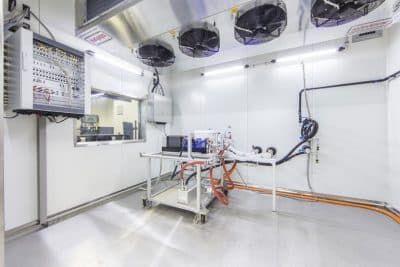The automotive industry is working in high gear on the mass-market introduction of hydrogen and fuel cell technologies. To support their efforts, AVL List partnered with HyCentA Research to develop and build test equipment for researching polymer electrolyte membrane or PEM systems. The result has been a unique research setup that makes it possible to analyze fuel cell systems by simulating the vehicle, driver, drive cycle, powertrain and other car components, such as battery, electric motor and gear, in real time. The stand can be used for applied science projects on energy and thermal management, calibration and integration at vehicle and subsystem level, and investigations into component behavior, cold starts and material aging under real-life ambient and operating conditions.
FCEVs’ range and refueling time (three to five minutes) are similar to conventional cars powered by diesel or gasoline. A fuel cell’s significantly higher energy density compared to a battery lowers powertrain weight and costs, making hydrogen a particularly recommendable option in scenarios requiring high power output and large amounts of energy (heavy loads, high mileage).
Hydrogen-powered PEM fuel cell systems have proved to be the most promising technology in use today. They offer a great many benefits (e.g., zero emissions locally, high efficiencies, great volume-based and gravimetric energy densities) and the potential for low manufacturing costs. Individual cells containing the bipolar plates, the gas diffusion layers, and the electrode and polymer membrane are already as thin as 1 to 1.2 millimeters throughout. The catalyst is typically made of platinum compounds and the ion-carrying membranes are superacids that need fine-tuned water management to transport those ions. The resulting stacks are compact, high-performance components. Even today, their specific output is 3 to 3.5 kilowatts per liter when installed in mass-market vehicles.
…
Research infrastructure
The above, coupled with a subsequent increase in research and development potential, has generated demand for various test stand uses. One important application is the analysis of degradation causes and their impact on a system’s lifetime. Crucial research needs to be done into what materials are suitable for stacks and what impact BoP – balance of plant – elements and operating conditions have on declining performance.
…
These prerequisites and activities can be met and implemented with the use of the innovative Highly Integrated Fuel Cell Analysis Infrastructure. The test stand, which received financial support from the Austrian Research Promotion Agency – FFG and the Federal Ministry of Science, Research and Economy – BMWFW was developed in partnership between HyCentA Research and AVL List and set up by the former at the Graz University of Technology. It marks a milestone in the design of test stands for PEM fuel cell systems.
Real-life conditions have been made possible by a climate chamber offering temperatures between minus 40 °C and plus 85 °C to simulate extreme ambient operating temperatures to the fuel cell and BoP elements, for example, as would be the case near the arctic circle or in Death Valley. These tests additionally use the hardware-in-the-loop method to include a feed-in of all media, such as air, hydrogen and cooling fluids, based on a typical operating scenario. Driver, vehicle and drive cycle data and BoP and powertrain information can be changed and transmitted as virtual parameters to the fuel cell system in real time.
R&D activities
One field in which HIFAI research activities are concentrated is the investigation of aging phenomena under real-life ambient and operating conditions. Automotive applications require a lifecycle expectancy of 5,000 to 8,000 hours at 10 percent performance degradation and highly variable power output, while stationary systems need to be up and running for up to 40,000 hours.
…
Operating this kind of equipment requires the just-in-time supply of hydrogen and air based on predefined, configurable settings and high-precision flow metering. A new supply system satisfies these needs by offering a greatly variable setup of mass flows, relative humidity levels, temperatures and system pressures. These thermodynamic properties influence each other, presenting challenges especially if operating parameters do not remain constant. Thanks to a non-linear multi-parameter control system, they can be provided in a suitable manner.
The HIFAI test stand also facilitates the design of novel operating strategies and PEM fuel cell calibration, as especially the complex interactions between BoP elements and stack come with their own set of difficulties.
At present, the control devices integrated into fuel cell systems and vehicles must be calibrated by hand or semi-automated. However, a calibration of several thousand parameters complicates things considerably. The HIFAI test stand solves this problem of multi-variable optimization with the help of software that processes such tasks by means of a real-time capable, model-like approach based on design of experiments methods. It increases the potential for enhancements and improves the efficiency of new advances and the rate at which they occur.
Further R&D activities …
Ideal engineering tool
HyCentA is an independent, non-university research organization whose innovative idea offers R&D departments at system suppliers and OEMs a valuable tool to speed up in-house processes. In close collaboration with universities and engineering companies, it has been working tirelessly to improve HIFAI and expand it in modules based on requirements from industry and research. The test stand as an integrated development tool will be key to efficient zero-emission transportation in the future.
Authors: Dr. Alexander Trattner, Stefan Brandstätter, Michael Striednig, all from HyCentA Research GmbH, Graz, Austria




























0 Comments